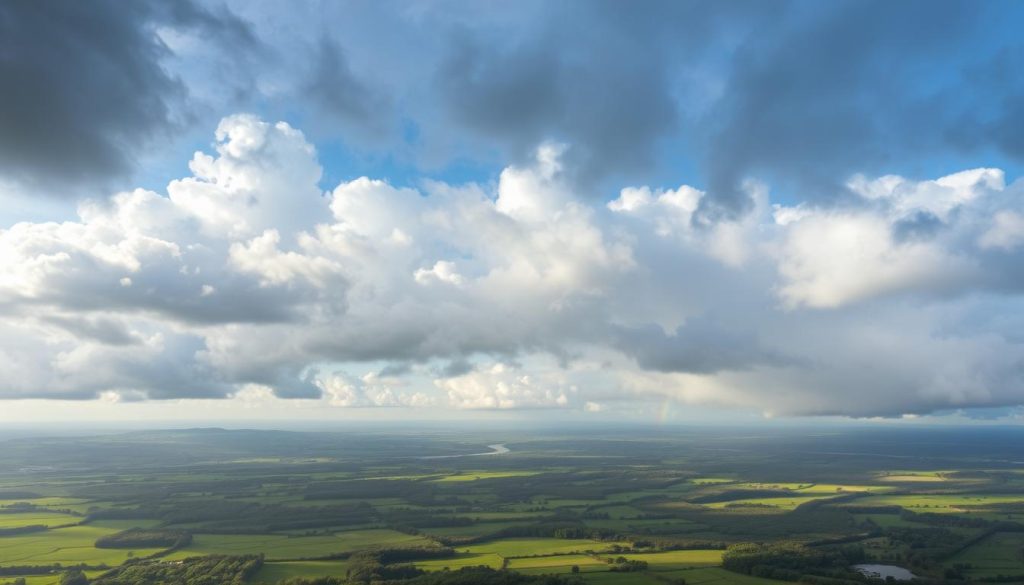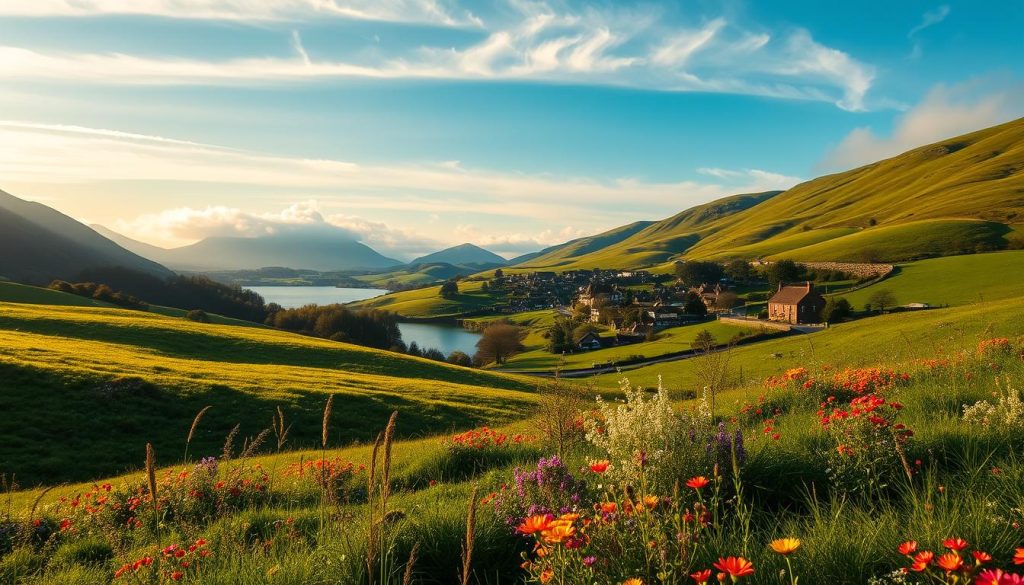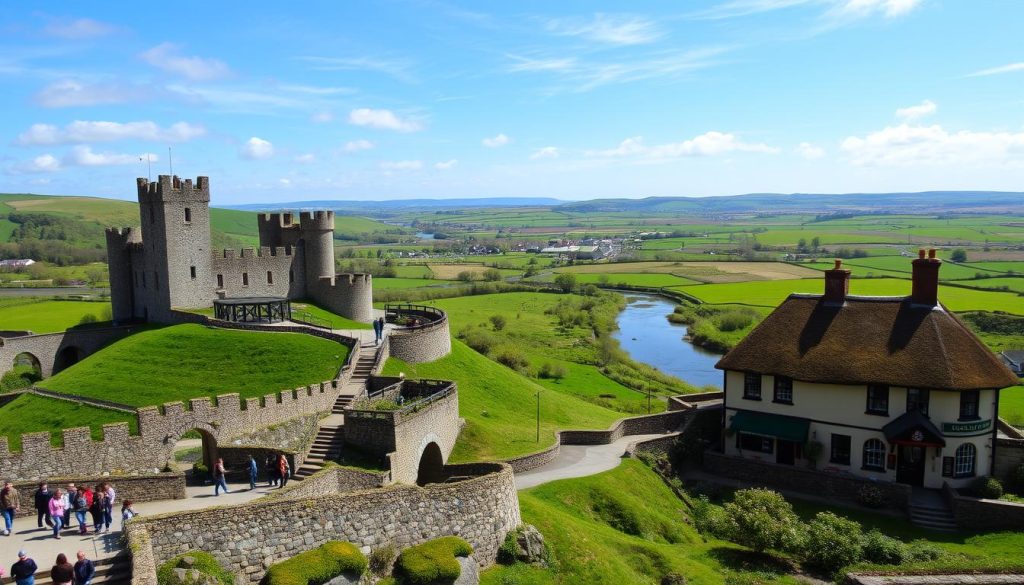Have you ever wondered why some travelers seem to have the perfect experience while others struggle with unpredictable conditions? The secret lies in understanding the weather patterns of your destination. Planning your journey around the right time can make all the difference.
Known for its lush landscapes and ever-changing skies, this destination offers a unique charm. However, its weather can be unpredictable, even during the summer. Rainfall can occur at any day, so being prepared is key to enjoying your trip.
This guide will help you navigate the best months to visit, highlighting seasonal attractions and insider tips. Whether you’re exploring vibrant festivals or serene countryside, knowing what to expect ensures a smoother and more enjoyable adventure.
Key Takeaways
- Understanding weather patterns enhances your travel experience.
- Rainfall can occur at any time, so always be prepared.
- Summer months bring vibrant festivals but also larger crowds.
- September offers warmer temperatures and fewer tourists.
- Historical data shows even summer days can bring rain.
Understanding Ireland’s Unique Weather Patterns
The key to a seamless journey lies in decoding the local climate. This destination’s weather is known for its unpredictability, but with the right knowledge, you can plan your trip effectively. Let’s dive into the temperature trends, rainfall averages, and seasonal shifts that define this region.

Exploring Temperature Trends and Rainfall Averages
Temperatures here rarely drop below freezing or climb too high, making it a comfortable destination year-round. For example, Dublin enjoys a moderate climate, with July averaging 68°F (20°C). In contrast, northern areas like Malin Head experience cooler conditions, with January lows around 38°F (3°C).
Rainfall is a constant companion, even in summer. January in Malin Head sees an average of 19 rainy days, while Dublin’s wettest months are November through January. Knowing these patterns helps you pack appropriately and schedule activities wisely.
Seasonal Variations: From Mild Winters to Lush Summers
Winters here are mild but wet, with temperatures ranging from 41 to 43°F (5 to 6°C). Snow is rare, and daylight hours are shorter, with December offering only about seven hours of sunlight. However, this season has its charm, with cozy pubs and festive celebrations.
Summers are lush and vibrant, with temperatures averaging 58 to 61°F (14 to 16°C). Daylight stretches from 4:30 AM to 10:30 PM, giving you ample time to explore. While rain is still possible, it’s the driest season, perfect for outdoor adventures.
“The weather here is as dynamic as its landscapes. Being prepared ensures you can enjoy every moment.”
| Month | Average Temperature (°F) | Rainfall (inches) |
|---|---|---|
| January | 47 | 4 |
| July | 64 | 3.1 |
| October | 56 | 4.1 |
Understanding these patterns can transform your travel experience. Whether you’re exploring bustling cities or serene countryside, being weather-ready ensures a smoother and more enjoyable adventure.
Ireland: Best Months for a Weather-Savvy Trip
Understanding seasonal changes ensures you make the most of your journey. Each season brings its own charm and challenges, so knowing what to expect helps you plan better. Let’s explore the weather patterns across spring, summer, autumn, and winter to guide your decisions.
Comparing Spring, Summer, Autumn, and Winter Conditions
Spring is a refreshing time to visit, with temperatures ranging from 46 to 54°F (8 to 12°C). The landscapes come alive with blooming flowers, but occasional rain showers are common. Summer, on the other hand, is warmer, with averages around 61°F (16°C). It’s the driest season, but rainfall can still surprise you.
Autumn offers a mix of mild temperatures and vibrant foliage. September is particularly good, with fewer crowds and pleasant weather. Winter is mild but wet, with temperatures rarely dropping below freezing. Snow is rare, making it a cozy time for indoor activities.

Monthly Breakdown: What to Expect Throughout the Year
Here’s a closer look at what each month brings:
- June: Average temperatures hover around 61°F (16°C), making it ideal for outdoor adventures. Daylight lasts up to 17 hours, giving you plenty of time to explore.
- September: With temperatures around 59°F (15°C), this month is perfect for avoiding summer crowds while enjoying pleasant weather.
- December: Expect cooler days, with averages of 47°F (8°C). Rain is frequent, but festive celebrations add warmth to your trip.
Even within a season, conditions can vary. A sunny morning might turn into a rainy afternoon, so always be prepared. Understanding these patterns ensures you’re ready for whatever the day brings.
“The beauty of this destination lies in its ever-changing skies. Embrace the unpredictability, and you’ll find magic in every moment.”
Planning Your Trip: Accommodation, Transportation, and Local Experiences
Planning your trip to Ireland involves more than just packing; it’s about smart decisions on where to stay and how to get around. Whether you’re exploring bustling cities or serene countryside, having a solid plan ensures a stress-free adventure.
Getting Around: Flights, Car Rentals, and Public Transportation
Getting around Ireland is easier than you might think. Major cities like Dublin have excellent public transit systems, including buses and trains. For rural adventures, renting a car is your best bet. Apps like Free Now make hailing taxis simple, while Enterprise offers reliable car rentals.
If you’re flying in, Dublin, Shannon, Cork, and Ireland West are the main international airports. Booking flights early can save you money, especially during peak travel months like July and August. For intercity travel, the Enterprise Service connects Belfast and Dublin efficiently.

Finding the Perfect Stay: Hotels, B&Bs, and Airbnbs in Dublin and Beyond
Choosing the right accommodation depends on your travel style and budget. Hotels like The Westin in Dublin offer luxury, starting at $340 per night. For a cozier experience, consider B&Bs, which often include breakfast and local insights. Airbnbs are ideal for longer stays or group trips.
Peak travel season runs from June to September, so book early to secure your preferred stay. If you’re visiting in May or October, you’ll find better deals and fewer crowds. Here’s a quick comparison of your options:
| Option | Best For | Average Cost/Night |
|---|---|---|
| Hotels | Luxury, convenience | $200-$400 |
| B&Bs | Local charm, breakfast included | $80-$150 |
| Airbnbs | Groups, longer stays | $100-$300 |
No matter where you stay, make sure it’s close to your planned activities. This saves time and makes your trip more enjoyable. With the right planning, your Irish adventure will be unforgettable.
Seasonal Attractions and Events Across Ireland
Exploring Ireland’s seasonal attractions offers a mix of vibrant culture and breathtaking landscapes. Each month brings unique experiences, from lively festivals to serene outdoor adventures. Whether you’re planning a trip in spring or autumn, there’s always something special to discover.
Cultural Festivals and Iconic Irish Celebrations
Ireland’s cultural scene is rich and diverse, with events that showcase its heritage. In June, Bloomsday in Dublin celebrates James Joyce’s Ulysses, attracting literature enthusiasts from around the world. Traditional music festivals, like the Fleadh Cheoil, bring towns alive with fiddles and flutes.
March is another good time to visit, with St. Patrick’s Day celebrations taking center stage. Parades, green attire, and lively pub scenes make it a memorable experience. These festivals are perfect for immersing yourself in the local culture and meeting fellow travelers.

Outdoor Adventures: Hiking, Scenic Drives, and Historic Sites
For those who love the outdoors, Ireland’s landscapes are a dream come true. The Wild Atlantic Way offers stunning coastal drives, with stops at charming villages and dramatic cliffs. Hiking trails like the Wicklow Way take you through lush forests and rolling hills.
Historic sites, such as the Cliffs of Moher and ancient castles, are must-see attractions. These places are especially beautiful in autumn, when the foliage adds a golden touch to the scenery. Always check the weather forecast, as conditions can change quickly.
“Ireland’s charm lies in its ability to surprise you—whether it’s a hidden trail or a spontaneous festival, every day is an adventure.”
Planning your vacation around these attractions ensures a well-rounded experience. Pack layers and waterproof gear to stay comfortable, no matter the season. With the right preparation, you’ll make the most of your travel and create lasting memories.
Insider Tips for a Weather-Ready Journey
Navigating the ever-changing skies requires smart planning and the right gear. Whether you’re exploring vibrant cities or serene countryside, being prepared ensures a smoother and more enjoyable adventure. Let’s dive into practical tips to help you stay ready for any weather.
Essential Packing Advice and Weatherproof Clothing
Packing for this destination means preparing for all conditions. Start with layering options—lightweight sweaters, thermal tops, and a waterproof jacket are must-haves. Even in summer, rain can surprise you, so always carry a compact umbrella.
Sturdy footwear is another essential. Whether you’re hiking trails or strolling through cobblestone streets, waterproof boots will keep your feet dry and comfortable. Don’t forget accessories like gloves and a scarf for cooler months.
How to Adapt Your Schedule for Unpredictable Weather
Flexibility is key when planning your day. If rain interrupts your outdoor plans, have indoor alternatives ready. Museums, galleries, and cozy cafes are great options to stay dry while still enjoying your trip.
Make the most of sunny spells by prioritizing outdoor activities during those hours. Early mornings often have clearer skies, so plan hikes or scenic drives accordingly. Apps like Met Éireann can help you stay updated on real-time weather changes.
“The beauty of this destination lies in its unpredictability. Embrace it, and you’ll find magic in every moment.”
Here’s a quick checklist to keep in mind:
- Pack layers for varying temperatures.
- Always carry a waterproof jacket and umbrella.
- Plan indoor activities as backups for rainy days.
- Use weather apps to stay informed.
With these tips, you’ll be ready to face any weather challenge, making your travel experience smoother and more enjoyable.
Conclusion
Planning a memorable journey starts with understanding the local climate and seasonal highlights. By choosing the right time to visit, you can enjoy vibrant festivals, fewer crowds, and pleasant weather. September, for example, offers a perfect balance of warmth and tranquility.
Being prepared for unpredictable conditions is key. Pack layers, waterproof gear, and always have a backup plan for rainy days. This ensures you can make the most of your travel, whether you’re exploring bustling cities or serene countryside.
With the right planning, from booking accommodations to scheduling activities, you can fully embrace the charm of this destination. Use the tips and insights from this guide to make informed decisions and create lasting memories.
Whether it’s a short vacation or an extended holiday, this resource will help you confidently explore every season. Keep it handy for future trips and enjoy every moment of your adventure.
The above is subject to change.
Check back often to TRAVEL.COM for the latest travel tips and deals.
Here are some Tours & Sightseeing suggestions that might pique your interests!
